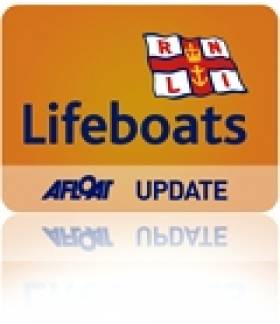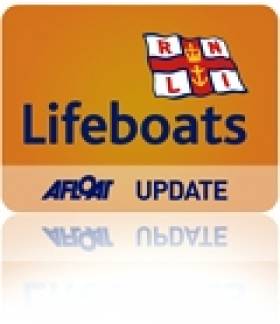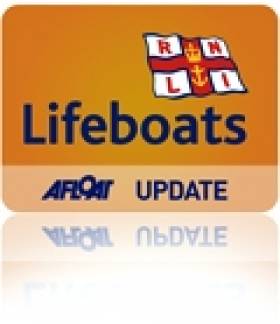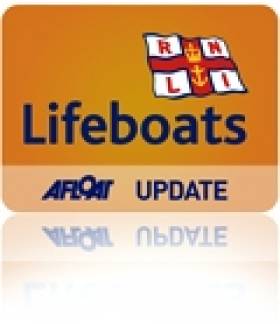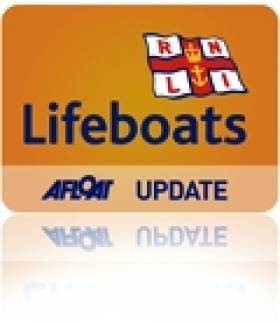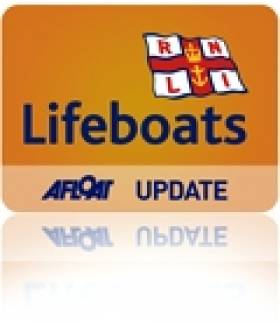Displaying items by tag: Kilrush
Charlie McGibney 1928 – 2014
#rip – The sea, once it casts its spell, will hold you in the net of its wonder forever. A thought that left Dublin native Charlie McGibney spellbound for his 85 years. From a very young age and through all his journeys taken over sea and land throughout his long, distinguished and caring life, Charlie took his final journey this week after he peacefully passed away at his home in Tieraclea, Tarbert, County Kerry on February 13 last.
Born in 1928 and originally from Inchicore, Mr McGibney developed and harnessed his interest and love for the sea over many years culminating in stewardship roles with many of the countries national sailing classes and associations.
Through sailing and the his maritime links and bonds, Mr McGibney is fondly remembered throughout the community, both far and wide with the esteem his presence would hold.
A founder member and former Commodore of Tarbert Island Maritime Club, Mr McGibney held a position of governor of RNLI together with a secretariat role for the Topper International Class Association.
A regional race officer with the Irish Sailing Association, Mr McGibney was very much involved with the Mermaid Class Association. A former commodore and member of Foynes Yacht Club as well as Tralee Bay Sailing Club, the avid boat builder was never far from the sea, even in his later years at his Tarbert home.
Co owner of the class winning Dehler Optima 101 yacht 'Disaray' on Ireland's west coast, Mr McGibney was also a member of the West of Ireland Off Shore Racing Association (WIORA) of which his son Simon is Commodore. He was also involved with and a member of the historic Royal Western Yacht Club of Ireland.
Most notably in 2005, aged 77, the able seaman and mariner was the leader of the assault to the Scottish Sailing Series - Tarbert to Tarbert with three generations involved.
At 85 and the beloved husband of the late Ita, Charlie McGibney peacefully passed away leaving behind a wide circle of family and friends. He is survived by daughter Carol; sons, Thomas, George, Gerard, John Raymond, Damien, Rory and Simon, inlaews, grand children and great children.
It is to the land he may lay, but it is to the sea he will look as Mr McGibney's final resting place is at St Mary's New Cemetery following requiem mass at the adjoining church in Tarbert.
Donations, if desired to the RNLI.
Ar dheis de go raibh an anam.
Howth, Kilrush Lifeboats Launch In Gale Force Winds At Weekend
#RNLI - Howth RNLI has brought six people to safety on Saturday evening (2 November) after their 37ft yacht got into difficulty north of Dublin Bay.
The volunteer crew was requested to launch their all-weather lifeboat by the Irish Coast Guard shortly after 6pm following a report that a 37ft yacht was unable to safely enter the harbour from one mile east of Howth Harbour.
The lifeboat, under coxswain Robert Duffy and with six crew members onboard, launched in five minutes into gale force winds and made its way to the scene.
Weather conditions were difficult, with winds blowing Force 8 to 9 at the time and gusting to 45 knots.
The lifeboat located the yacht in a calm, sheltered bay off Howth Head. A lifeboat crew member was then transferred to the disabled boat which had encountered a mechanical problem. A tow line was then established and the lifeboat brought the vessel to safety at Howth at 7pm.
Speaking following the call-out, Duffy said: "This was a challenging call-out for our volunteer crew tonight given the gusty weather conditions and the darkness.
"Thankfully we were on scene quickly and using our training, we were able to assist the six crew members on board the yacht and bring them safely to shore."
Elsewhere, Kilrush RNLI brought a yacht which was dragging its mooring off Hogg Island to safety on Saturday morning.
The volunteer crew was requested to launch their inshore lifeboat at 9.40am, and within minutes they had sighted the vessel, which was located a short distance from Cappa Pier.
A crewmember was put aboard the vessel to start the engine and bring it to another secured mooring. In the meantime, the crew put a line on the strayed mooring line and towed it out of the way from the main shipping line.
Winds were extremely strong gusting up to Force 8, and it was decided in the interest of safety that the yacht be brought into Kilrush Creek Marina.
Kilrush RNLI lifeboat operations manager John Lamb praised the crew who he said put their skills and training to good work in what was challenging weather conditions.
"When volunteer crew members put in the time for training, their efforts pay off on call-outs such as this one this morning and thankfully we were able to bring this vessel to safety," he said.
Kilrush Lifeboat Diverts From Training To Remove Floating Object
#RNLI - Kilrush RNLI was on a regular training exercise on Tuesday evening 22 October when a member of the public informed them of an object floating in the water about one mile east of Cappa Pier on the Shannon Estuary in Co Clare.
The volunteer crew informed Shannon Coast Guard, which in turn requested that the inshore lifeboat, helmed by Pauline Dunleavy, divert to the location.
Within minutes the crew had a vision of a 15ft-long piece of tree root floating by Aylevarroo. They quickly brought it aboard the lifeboat, securing it at the stern of the boat.
On returning to the station, Kilrush RNLI deputy launching authority Fintan Keating Sr paid tribute to the member of the public who spotted the object in the water.
"If the item had crossed the path of the Shannon car ferry or other boats on the river, we could have encountered a worse situation," he said. "It’s always good to dial 112 or 999 if people are ever concerned."
Kilrush Lifeboat Assists More Drifting Boats In Shannon Estuary
#RNLI - There was another call-out for the Kilrush lifeboat to retrieve a boat broken free of its moorings on Tuesday 17 September, following Sunday's assist of a boat on the rocks at Mount Trenchard in the Shannon Estuary.
The volunteer crew of Kilrush RNLI launched quickly on Tuesday afternoon after a report that the boat was adrift off Glin in Co Limerick. Conditions on the day were very unfavourable with winds blowing south-westerly and gusting to Force 8.
The helm dropped one of the lifeboat crew at Glin Pier, where a number of locals brought him to the area where the boat was gone aground. Another crew member waded out to catch a tow line from the lifeboat, then proceeded to set up a long tow and was pulled to safer waters.
The lifeboat then made its way to Glin pier were the owner was located and the vessel was tied up securely.
But the Kilrush lifeboat wasn't finished its duties yet, as around 4.45pm the coastguard relayed a message reporting another small vessel gone aground at Hog Island, near Cappa Pier at Kilrush.
The crew quickly turned westwards toward this area where they found a sailing boat up on the rocks on the spit at Hog Island.
Again the speed of the crew proved invaluable as they transferred one of their crew onto the shore, where he quickly established a towline. The Kilrush crewman stayed on the vessel, communicating all the time with the lifeboat and the coastguard. Within five minutes the boat was tied up at Cappa Pier and safely secured.
Kilrush RNLI lifeboat press officer Pauline Dunleavy said: “It is at times like these that constant training pays off. The lifeboat crew braved the elements and brought a satisfactory outcome to the owners of these vessels.
"I would advise people to check that their mooring lines are strong and stable.”
Elsewhere, Crosshaven RNLI brought a troubled fishing boat with one person onboard to safety yesterday evening (18 September).
A mobile phone call to one of the Crosshaven RNLI crew members alerted them to a disabled fishing vessel seven miles south of Roches Point.
The pagers were activated and the volunteer crew of Kieran Coniry, Ian O'Keefe and Vincent Fleming launched to the aid of the stricken vessel at 4.45pm. With a north westerly Force Four wind and good conditions, the lifeboat made good progress and arrived a short time later.
The casualty vessel with one person on board had failed to restart its engine and was taken in tow by the lifeboat. The 37ft vessel was towed to Crosshaven Pier, arriving back at 7.30pm.
Kilrush Lifeboat Launches To Boat Broken Free of Moorings
#RNLI - Kilrush RNLI launched on Sunday 15 September shortly after 1pm following a request from Valentia Coast Guard to go to the aid of a boat which had broken its moorings off Labasheeda in Co Clare.
The volunteer lifeboat crew assembled and launched immediately, heading for the indicated area. Conditions were blowing quite hard at the time, with north westerly winds blowing.
The crew battled their way to the scene reaching the location at 2pm, whereby they set up watch and located the 6.5m vessel on the rocks at an area known as Mount Trenchard, east of Glin, near Foynes in Co Limerick.
Weather conditions were very strong and gusting Force 8, and in the interest of safety the decision was made to leave the vessel which was securely placed where it had gone aground with a view to it being removed to Foynes Harbour the following morning.
Kilrush RNLI lifeboat operations manager John Lamb said he was happy with the outcome and in view of safety of his crew that the right call was made on this occasion.
#RNLI - Kilrush RNLI in Co Clare was diverted from exercise training on Tuesday 28 May when the lifeboat came to the assistance of a 10ft boat.
The volunteer lifeboat crew at Kilrush were returning from their weekly training exercise at 8.45pm when they were requested to go in search of a vessel that had lost its moorings at Tarbert pier.
After relaying the situation to the Coast Guard at Valentia and getting permission to launch, the inshore lifeboat Edith Louise Eastwick set off to the Tarbert area and carried out an extensive search. Weather conditions at the time were blowing force three to four northerly winds.
The crew continued eastwards and crossed over to the Labasheeda region where they located the 10ft punt off Kilkerrin Point.
After securing the vessel to the lifeboat, the crew brought it back to Tarbert pier where the owners were waiting. The vessel was handed over and a request that a new mooring line be put in place was made.
The call out was crew member Charlie Glynn’s first as helm, having secured the position a month ago.
Earlier that day, Enniskillen RNLI was launched to reports of a cruiser which had run aground on Lower Lough Erne in Co Fermanagh.
The volunteer crew on their inshore lifeboat Joseph and Mary Hiley and the Rescue Water Craft (RWC) proceeded to Inish Davar, two miles from the station. Weather at the time was clear with calm waters.
The crew arrived at the location to find the owner of the vessel on another boat and assisting the casualty boat and the two men and two women who were on board and safe and well. The lifeboat crew stood off and observed from a distance.
#RNLI - Kilrush RNLI lifeboat station was put on standby on Monday 29 April for an aircraft with engine trouble, and later called to a person who drove into the water.
At 2pm on Monday the Irish Coast Guard at Shannon alerted the station authorities that there was a private aircraft descending in the region of the River Shannon with engine problems. It was reported that there were four people on board.
After a half an hour the lifeboat crew were informed the plane made a safe landing at Shannon Airport and the station was stood down.
Later that day at 8.47pm pagers were activated by the coastguard in Shannon to alert the crew that a person was reported to have driven off the road into the water in the area of Labasheeda, about nine nautical miles from Kilrush.
The lifeboat crew assembled and within eight minutes were launched and on their way to this area. Conditions on this evening were most favourable.
After five minutes they were stood down as members of the local Gardai had managed to rescue the driver and bring him ashore. An ambulance was standing by at this area to assist the casualty and team of helpers.
Kilrush lifeboat operations manager John Lamb praised the speed of the crew and the efficiency on which the launch took place.
“At times like these it’s always good to know that our team are trained to the highest standards to deal with callouts such as this evening,” he said.
In other news, President Michael D Higgins will pay a special call to Courtmacsherry RNLI lifeboat station this weekend during an official visit to the Cork village.
While there he will view an impressive historical exhibition which is running all through the May bank holiday weekend.
The exhibition, which has been planned for months, will have a strong emphasis on the lifeboat and its crew with most families in the village having had loved ones serving as volunteer lifeboat crew since 1825.
To mark this fact, local families have displayed the name of that lifeboat crew member outside their home and placed a pair of wellington boots on their doorstep. The yellow lifeboat boot is an iconic piece of the RNLI crew members' kit.
President Higgins is expected to arrive in Courtmacsherry at 4pm on Sunday 5 May and will first visit the lifeboat station where he will be met by volunteer lifeboat crew past and present and members of the station management and fundraisers.
The station has a proud history of lifesaving with 14 awards for gallantry.
Courtmacsherry RNLI launched after the sinking of the Lusitania in 1915 when the lifeboat crew rowed for over three hours in a desperate bid to reach survivors from the torpedoed vessel off the Old Head of Kinsale.
And during the Fastnet Race tragedy of 1979, in which 15 sailors lost their lives, the Courtmacsherry lifeboat was among of group of RNLI boats that spent 75 hours at sea in 60-knot winds.
Kilrush RNLI Responds To 'Flare' Sightings Off West Coast
#RNLI - Kilrush RNLI launched twice on Tuesday 19 March to a reported flare or red smoke sighted off the coast on the River Shannon.
On both launches at 12.15pm and later at 9.27pm, both crews quickly assembled and set off to the locations along the river outlined by Valentia Coast Guard.
On the first callout, the volunteer lifeboat crew searched from Querrin Point to Cappa village following accounts from the public that a small aircraft had been seen aflame while on approach.
Shannon helicopter and crews from the Kilkee and Mallow coastguard who were involved with another incident in Ballybunnion, crossed the waters and joined in the search.
After two-and-a-half hours the search was stood down as the Aviation Department stated there were no aircrafts in the region. The conclusion thus far is that the object seen was a meteorite burning up in the atmosphere.
Shortly before 9.30pm, the inshore crew was paged again by Valentia Coast Guard to launch in response to members of the public who saw flares in the Kilrush area.
The lifeboat launched and after an hour was stood down as there was no evidence along the shore from Cappa to the Moneypoint area. The unit of the Kilkee Coast Guard also carried out an intense shore search.
Kilrush RNLI helm and volunteer lifeboat press officer Pauline Dunleavy praised the members of the public who put these calls into action, even though in this case they turned out to be false alarms.
"We would urge anyone who does see anything suspicious out on the water to dial 999 without delay," she said. "It could be the reason a life was saved."
Kilrush RNLI Rescues Five From Stranded Boat
#RNLI - Kilrush RNLI launched on Thursday afternoon (21 February) after pagers were set off by Valentia Coast Guard to the Foynes area, where it was reported that a boat had lost engine power with five people on board.
Within minutes the crew assembled and set out to the location to investigate. Within 25 minutes they located the vessel and quickly set up a long tow. Tides were running and weather conditions were reaching force 7 to 8.
For their safety the five men were taken on board the lifeboat, while a lifeboat crew member was transferred onto the casualty vessel to oversee the tow. On establishing that the men were fine, the lifeboat proceeded to Tarbert Pier. At this stage the Irish Coast Guard helicopter Rescue 115 from Shannon was also on scene.
Within an hour the Kilrush RNLI lifeboat reached Tarbert Pier, where the lifeboat crew assisted the men in tying up their vessel.
Lifeboat helm Tom Blunnie praised the work of his crewmen in this rescue, stating that “under such conditions it’s great to know that our training pays off when calls like this occur.”
The crew on the day were helm Tom Blunnie, Pauline Dunleavy, Fintan Keating and Charlie Glynn.
IWDG Secures 75% Funding for Celtic Mist Refit
#TALL SHIPS - The Irish Whale and Dolphin Group (IWDG) has secured three-quarters of the funding it required to refit its research vessel Celtic Mist.
According to The Irish Times, the Clare Local Development Company has approved the allocation of a €48,000 grant towards the refurbishment of the ketch.
The work will be carried out by Cathal Blunnie and several sub-contractors, and involves stripping down the main cabin and removing the bath and shower to increase space for crew berths.
While the ship's clock will be retained, the ship’s wheel in the main cabin will be removed and presented to the Haughey family as a gesture of appreciation.
As previously reported on Afloat.ie, the 52-foot yacht - which was gifted by the Haughey family to the IWDG to assist in its marine wildlife conservation work - entered dry dock last November in preparation for the refit work, after relocating to its new berth at Kilrush, Co Clare in July.
This followed its last jaunt at sea in its former guise, completing a leg of the Tall Ships Races from Waterford to Greenock in Scotland.
The cost of refurbishing the yacht for research and training purposes is expected to top €60,000, with an annual running cost of some €20,000, for which the IWDG is seeking ongoing financial assistance.
The group aims to get the Celtic Mist back at sea before the summer.




























